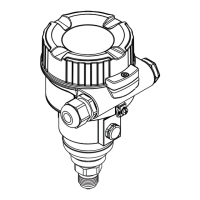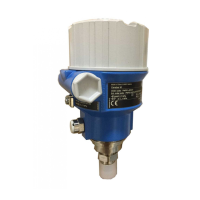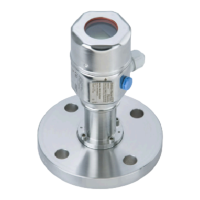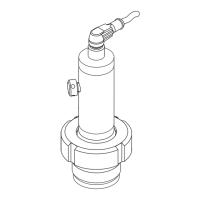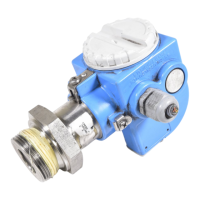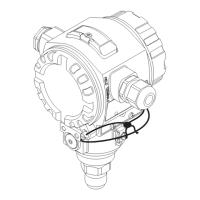Cerabar M PMC51, PMP51, PMP55
114 Endress+Hauser
Function and design
Diaphragm seals separate the measuring system from the process.
A diaphragm seal system consists of:
• A diaphragm seal
• A capillary tube or a temperature isolator if necessary
• Fill fluid and
• a pressure transmitter.
The process pressure acts via the process isolating diaphragm of a diaphragm seal on the liquid-filled
system, which transfers the process pressure to the sensor of the pressure transmitter.
Endress+Hauser delivers all diaphragm seal systems as welded versions. The system is hermetically
sealed, which ensures greater reliability.
The diaphragm seal determines the application range of the system on the basis of
• The diameter of the process isolating diaphragm
• The process isolating diaphragm: stiffness and material
• The design (oil volume)
Diameter of the process isolating diaphragm
The greater the diameter of the process isolating diaphragm (less stiff), the smaller the temperature
effect on the measurement result.
Stiffness of the process isolating diaphragm
The stiffness depends on the diameter of the process isolating diaphragm, the material, any existing
coating, the thickness and shape of the process isolating diaphragm. The thickness of the process
isolating diaphragm and the shape are determined by the design. The stiffness of a process isolating
diaphragm of a diaphragm seal influences the temperature application range and the measuring
error caused by temperature effects.
The Endress+Hauser TempC membrane: Highest accuracy and process safety when measuring
pressure and differential pressure using diaphragm seals
To measure with even greater accuracy in these applications and increase process safety, Endress
+Hauser has developed the TempC diaphragm which is based on a completely revolutionary
technology. This diaphragm guarantees the utmost level of accuracy and process safety in diaphragm
seal applications.
• The very low temperature effect minimizes the effect of process and ambient temperature
fluctuations, thereby guaranteeing accurate and reliable measurements. Measurement
inaccuracies caused by temperature are reduced to a minimum.
• The TempC membrane can be used at temperatures between –70 °C (–94 °F) and
+400 °C (+752 °F). This guarantees maximum process safety even for very long sterilization and
cleaning cycles (SIP/CIP) in tanks and pipes at high temperatures.
• With a smaller process connection, the new diaphragm measures at least as accurately as a
conventional diaphragm with a larger diameter. With a smaller process connection, the new
membrane measures at least as accurately as a conventional membrane with a larger diameter.
• Due to the geometry of the membrane, an overshoot occurs initially immediately following a
temperature shock. This results in a transient response, the duration and deviation of which are
significantly less compared to traditional membrane types. In the case of batch processes, these
shorter recovery times mean a far higher level of availability of the production facilities. For
TempC membranes, the effect of the overshoot on the output signal can be reduced by adjusting
the damping.
• In addition, TempC Membrane convinces customers by its better hygiene cleanability as well as
insensitivity to strong pressure load changes.
Ordering information:
See the Product Configurator for the individual process connection and the choice of process
isolating diaphragm.
Selection in the Applicator:
Under "Transmitter data" in the "Membrane material" field.
Capillary
As standard, capillaries with an internal diameter of 1 mm (0.04 in) are used.
The capillary tube influences the thermal change, the ambient temperature operating range and the
response time of a diaphragm seal system as a result of its length and internal diameter.

